THE MATRIX is an experience that producers, filmmakers, and audiences alike have been chasing the cultural and commercial high of like junkies ever since. In the immediate aftermath, if you were making a sci-fi adventure or an action flick, you were either intentionally trying to make a pale imitation, or trying as hard as possible to zag in the opposite direction. Not even the first two Matrix sequels could initially live up to the colossal fan expectations, even though many fans have reclaimed and reappraised them since. THE MATRIX is a hermetically sealed object: a collision of visual influences and iconography that are so immaculately curated and storyboarded within an inch of their lives that they synthesized and defined everything that was cool from our culture in 1999, calcified it, and influenced the shorthand terminology for “cool” ever since. The guns, the trenchcoats, the tiny sunglasses, the techno raves, bullet time—it’s all become a language so burned into our brains that even if you haven’t seen these movies, just hearing the words “matrix” or “cyberpunk” or “gritty future” probably conjures those exact images from the first movie.
How do you even begin to think about trying to replicate a phenomenon that singular?
You don’t, obviously. You can’t. Now that “The Matrix” has become so codified, it is impossible to create something that simultaneously satisfies the corpo demands for “more MATRIX” while also appealing to fans of the series when the whole draw of the original was its shock to our collective system. So why make a fourth MATRIX at all? This is where RESURRECTIONS busts in like The Kool-Aid Man, a movie that knows it cannot provide a simple, satisfying justification for its own existence and has instead decided to wrestle with that question in the intellectual mud. THE MATRIX trilogy has always been a metatextual trek through the nature of storytelling itself, investigating why these “chosen one” narratives repeat themselves over and over—all hammered home by RELOADED’s controversial, intentionally dense climax wherein The Architect explains that Neo is not “The One,” but rather the sixth in a series of Ones—but never before has that kind of existential creative crisis been so foregrounded the way it is here.
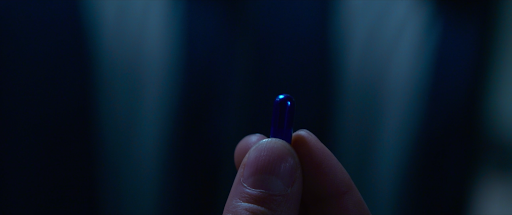
People called a relatively traditional, crowd-pleasing movie like THE LAST JEDI a bold, provocative subversion of the STAR WARS story just because it tinkered with the formula enough to elicit a mass temper tantrum from the worst dorks on the Internet, but THE MATRIX RESURRECTIONS is a true blockbuster subversion, and as a result you’re inevitably going to get people who say it sucks. I’ve seen so many attempted arguments claiming this fourth installment is just as cynical of a brand exercise as the Hollywood reboot culture it critiques, and I don’t entirely blame anyone for this line of thinking. We’ve grown so skeptical of the DEADPOOL spawns using a thin, in-on-the-joke veneer of “self-awareness” to deflect any and all critiques of their hollow IP maintenance practices that I understand why many people have a knee-jerk reaction to this movie. RESURRECTIONS provides the antidote to that very problem. There never was a choice of whether this movie would be made: the only choice was whether Lana Wachowski herself would be the one behind the steering wheel guiding it.
We live in a grave-robbing moment in culture, especially American movie culture, where nothing dead can ever stay dead, and no original idea we’ve ever had is free from the looming specter of a violent, forceful reboot. As occasional MGRM contributor Matty Monroe phrased it in his review of the new Spirit of the Beehive album, we are in the end times, the “pulling the copper wiring out of the walls” phase of American culture, no longer even trying to build new things at all but instead tearing apart the fabric of everything we’ve built thus far to try to get our fix one last time. RESURRECTIONS knows this. Lana Wachowski knows this. After the years of pitch meetings she undoubtedly had to sit through between REVOLUTIONS and now (a well of experiences she is clearly pulling from here), Wachowski knows that the bloodlust these Warner Bros. executives have for something that chases the box office results of the original is so insatiable that if she personally refuses to take part, like her sister Lilly chose to do; she is only opening the door for focus-group-friendly committees of cis writers who claim “THE MATRIX changed my life” to bastardize the legacy of the original works.
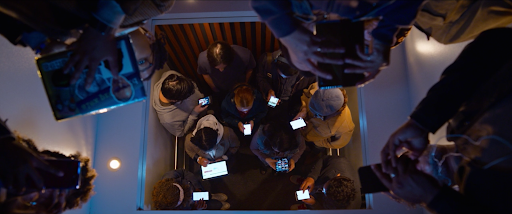
So Wachowski’s choice was either to submit herself to a wrestling match with the franchise machine that has come to define her professional career, once again boxing herself into a set of expectations she and her sister have been creatively running away from for years, or stand back and allow her vision to be cannibalized by a culture that exists to trivially recreate the past. You get to live in peace, but your creation will be revived as another asset to keep us in an endless cycle of outrage and mild placation. You call that a choice?
—
Wachowski approached RESURRECTIONS from top to bottom with an entirely new perspective. In describing this shift, Jonathan Groff said “Lana’s style of filmmaking has changed with mirroring her transition. She was explaining to us how, in her earlier work, she would storyboard things like they were comic books almost, and create exact frames of what she wanted as her way of literally controlling her narrative, because there was so much out of control inside of her. Then when she embraced her identity, this articulated itself in her work and opened her up to the idea of capturing the things that can’t be controlled.”
It’s easy to take potshots from minute one, with a thoughtful, but mostly mediocre retread mirroring Trinity’s entrance from THE MATRIX. The movie calls attention to this directly, with a character literally saying “so déjà vu, and yet it’s obviously all wrong.” These opening minutes are the only time THE MATRIX RESURRECTIONS comes close to what one may call “looking bad on purpose,” but every single visual choice harbors a deeper practical or thematic meaning essential to how the entire machine clicks. The opening purposefully resembles Netflix’s COWBOY BEBOP, showing you how the updated Matrix trivializes what was once impactful art and turns it into a piece of flavorless content designed to entertain a couple of kids for a few hours.
Not only does RESURRECTIONS, the first in the franchise to be shot digitally, look nothing like the original MATRIX, besides the returning faces and surface-level aesthetics of hot people wearing sunglasses and holding glocks, RESURRECTIONS deliberately refuses to speak in the the first movie’s tongue, despite the fact that it’s constantly making you think about that very specific iconography. Also notably different is that action no longer employs the kinetic wire-fu style of the legendary Yuen Woo-ping, with Wachowski not even tasking another modern equivalent like Reeves stuntman-turned-JOHN WICK-mastermind Chad Stahelski with the reins (even though he makes a hilarious cameo as Trinity’s chad husband literally named Chad, designed by The Matrix to cuck Neo for eternity). These decisions raise some reasonable questions. Why take me back to this thing I love if you’re not even going to attempt to be as technically precise and propulsive? What RESURRECTIONS is trying to do with its de-emphasization of action is tell you that it is speaking in a completely new language, visually, emotionally, and intellectually. If you try to watch it the way you watched the first movie, you will inevitably be disappointed.

These are all deliberate choices. Choices that you have the right to hate. Go ahead and rant and rave like the Merovingian (reprised brilliantly by Lambert Wilson) about how “art, films, books were all better! Originality mattered!” Or, declare that “movies are dead, games are dead, narrative… dead” as one of Deus Machina’s employees does in the movie’s hilarious post-credits scene. Knock yourself out. What this film is trying to tell you is that when you say “everything was better in the past,” you overlook the fact that you right now are the only one who can do anything to change that fact. THE MATRIX RESURRECTIONS is beckoning you to be the one to make that new thing. In the ouroboros-like structure of the film, its opening moment is the first of many times Lana is grabbing you by the shoulders as she asks you these questions. Do you really want to be fed the same thing you experienced before? Or do you want to experience something new, something human? This isn’t a traditional sequel, it is the epilogue we never knew these movies needed. Wachowski’s newest work is trying to deconstruct and reconstruct The Matrix and THE MATRIX in a new image. She’s trying to teach us how to fly again.
All of these changes attempt to reflect the way our digital existence in 2021 is so different from in 1999, a time when the internet was still an unexplored frontier. THE MATRIX RESURRECTIONS is a movie made right now, and thus has the clarity of mind to see that, as it currently stands, The Matrix has won. And it’s won pretty handily, in a blowout. We are so far from where we were as a culture in 1999, a time where discussion of “selling out” was commonplace in the art world, now a foreign concept to the influencers who pretend to have brand partnerships without the pay stubs to prove it. Advertising is the amniotic fluid in our pods, and it has become incredibly difficult to imagine a version of our life without its infectious spread.
We thought 1999 was the peak of consumer capitalism, that we were already living in a cyberpunk dystopia, but the truth we know in 2021 is that dystopia is so much more mundane than THE MATRIX predicted. Gone are the illicit underground raves where DJs blasted “Dragula” and sexy queer people writhed on dancefloors in latex. They are replaced with upscale coffee shops and eerily spotless San Francisco avenues, a famously queer city that has been “cleaned up” by crypto-facism. Nor is it a coincidence that the two primary villains are played by Jonathan Groff and Neil Patrick Harris, who both represent the textbook image of the defanged, white, cis, Pete Buttigieg vision of queerness that has been neatly assimilated into 2021’s hegemonic status quo. Harris and Groff are literally the primary antagonists in GLEE’s first season; she couldn’t be more obvious about this stuff if she tried.
—
Our current lives in real cyber-dystopia are nothing at all like the thrilling, stylized world THE MATRIX imagined in 1999. Life today is being trapped in a frictionless box, an aesthetically bland, but emotionally toxic game of SIMCITY where we are all kept just far enough away from what would truly set us free. Here we are, left to tear each other apart in an attempt to fill that void. Truthfully, most of us would gladly take the blue pill right now if it meant checking out of the reality we’re currently living in, and getting to opt out of the multiple compounding existential crises that we are looking down the barrel of and just eat the juicy steak. Desire and fear, baby.
But there’s a way to wake up.
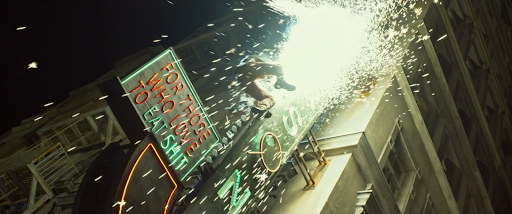
Besides the destructive, debris-blasting action, THE MATRIX’s most potent idea was symbolized by the binary choice Neo must make once he realizes that the life he was living was merely a computer simulation: to take the red pill or the blue pill. Choose between the comfort of a blissful ignorance (“pretending my life” as new character Bugs puts it) or an opportunity to know the truth, even if the freedom granted by true reality means living a terrifying future where humanity is barely hanging by a thread. I probably don’t need to tell you that this powerful metaphor immediately fell into the wrong hands, all of it willfully misunderstood and warped and perverted until it lost its original meaning entirely. Over time, in the wake of the first decade of bad actors repurposing “the red pill” to advance their own facist ideology, “THE MATRIX is secretly a trans allegory!” has become a sort of memed rallying cry that people continually bring up as a way to balm their own feelings about this willful misinterpretation. Moreover, it’s been a call to remind people of the egalitarian beliefs of its creators and the original intentions of their work. When Reeves was informed during an interview about the fact that THE MATRIX is a trans allegory, he simply, warmly, replied “cool!” Ultimately, taking back the red pill from the fascists, or even assessing the meta-fiction about the corporatization of Hollywood, isn’t what RESURRECTIONS is really about at its core, even if those ideas are both undeniably part of the puzzle.
The red and blue pill, and THE MATRIX series as a whole, are so powerful to trans people because the moment of truth in which one realizes that they are trans, that they have always been trans and were just repressing what they always knew to be true, feels so exactly, specifically like Neo learning that his whole life was a computer sim. It is at once a complete upending destruction of your whole life as you knew it, and like opening your eyes for the very first time. When I watched THE MATRIX after I had come out to myself, it was like watching a different movie entirely, like hearing a language I once thought I didn’t speak but could now understand perfectly. It’s the eureka moment of Morpheus explaining to me that “you’re here because you know something. What you know you can’t explain, but you feel it. You’ve felt it your entire life, that there’s something wrong with the world. You don’t know what it is, but it’s there, like a splinter in your mind, driving you mad.” He so perfectly summarized the mental state of where I was at that moment before I came out that it felt like The Wachowskis had pulled the words out of my own brain.
You can read countless excellent personal essays from trans people that dive into the trans readings of THE MATRIX trilogy, about the very specific resonance this story has for the trans community, or you can read Lilly Wachowski herself detail how the films have always functioned as such to the two trans women who created them. However, the inherent transness of THE MATRIX is not subtext to be appreciated only by trans people, and the transness of these movies is so much more multifaceted than just the coming out metaphor in selecting one colored pill over the other. It runs like a current, especially through RELOADED and REVOLUTIONS, which the Wachowski sisters made while even more actively in the process of questioning their own genders, and now this fourth, the first MATRIX made since both sisters have come out publicly.
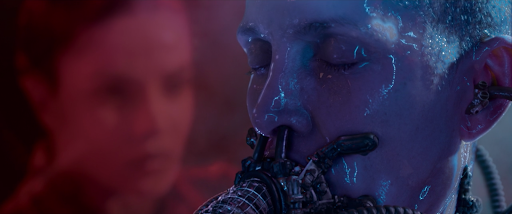
When we say “THE MATRIX is trans”, we are not trying to create a walled garden in which only the people on the inside of this community are the ones who actually “get it.” We are not trying to say these movies aren’t for cis people. But whenever I try to wax poetic about why exactly these movies are so important to trans people, especially RESURRECTIONS, I can practically hear the cis people in my life tune me out, like this is just an Easter egg. This read is often regarded as something that’s nice for trans people to have for themselves, but not something cis people need to care about in the context of ingesting THE MATRIX RESURRECTIONS. But this new movie makes the trans subtext explicit text, the constant undercurrent of transness in its characters and ideas foregrounded in a way that makes it truly impossible to ignore for anyone who is transgender like myself, and yet all I read about this movie is people getting hung up in its lore-shattering, metacommentary on popcorn entertainment, completely missing its profoundly open, beating heart.
—
From this point onward, I need you to trust me, to listen to me. To take a leap of faith and follow me all the way down this rabbit hole. To make a choice. When people like myself who are this deep in the weeds of THE MATRIX movies advocate for them strongly, it’s impossible not to sound like a dorm room philosopher on mushrooms crossed with an evangelical, free-love hippie trying induct you into their commune, and any point if you want to roll your eyes and call me “corny” or “stupid” as I read too much into THE MATRIX, you have every right to do so. Just like you have the right to call Lana Wachowski’s movie “corny” or “stupid.” You have that choice, this is what makes us human. But this movie is earnestly asking you to believe, to take it both seriously and sincerely, and if you want to get the most possible out of it, you need to approach it with an open mind and heart. I’m trying to free your mind, but I can only show you the door. You’re the one that has to walk through it.
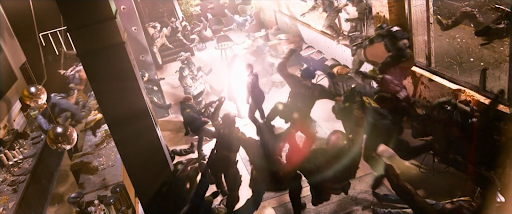
THE MATRIX is about love—about true love, about trans love specifically, conquering all. It’s about Neo choosing his love for Trinity and potentially risking the destruction of the entire human race. About the idea that the love between two trans people, two people who can see each other’s true selves through the lies The Matrix tries to tell us about ourselves, is the most sacred kind of connection in this world. THE MATRIX RESURRECTIONS is about the power of trans love as the salvation of all mankind, about how the very idea of transness is the skeleton key that unlocks the solution to the end to cyclical suffering, to the end of soulless art, and to the end of the struggle between man and machine. About how transness and transcending the binary are not just important to the many people like myself who would like to present their identity to the world in a way that does not conform to traditional cisnormative gender roles, but to all people of all walks of life. About how the idea of transness and transcending the binary can change your life even if you are completely happy in the gender you were assigned at birth or in the clothes you wear. About how, in recognizing the fact that we are all individually plugged into the capitalist binaries and white supremacies that subist our Matrix’s systems of abuse, we have a chance to wake up; to make a choice. And the two people who can help break us out of that cycle, to make us believe in true love, are Neo and Trinity, because Neo and Trinity are all of us.
THE MATRIX films are Jesus stories (the Wachowkis have never been “subtle” filmmakers), but the Jesus of this franchise is not Neo, The One who will save us all, but instead a binary-breaking duality of Neo and Trinity. The separation of Neo and Trinity in RESURRECTIONS, kept close but eternally away from each other in their pods after resurrection, puts forth that, as Juan Barquin put it, this essentialism “is what keeps these people in power. This is what keeps us apart. But when we come together? The binary transcends to become ‘The One.’” THE MATRIX RESURRECTIONS is about the limitless potential for humanity when we evolve beyond absolutist thought and realize that we are all one fluid, boundless mass linked together by love.
THE MATRIX RESURRECTIONS is about the Internet, not just “the Internet” as a vague boogeyman to be lectured about, but a movie that captures the very specific way that the modern Internet and its undergirding algorithms use human emotions as a fuel source, stuck in an endless loop of fury and placation that we all feel helplessly trapped in. Wachowski harnesses the way that these algorithms and data-driven tech companies absorb the things we love, like the alien from THE THING, and reflect our own passions back to us through a disfigured mirror; the way anything you put out into the internet immediately ceases to be your own and gets pulled in a million different directions by a million different people’s ideas of you and the thing you gave them. On the flip-side of being the greatest love story ever told, THE MATRIX RESURRECTIONS is also undoubtedly a film about suicide, and specifically its deathly shadow cast over trans life. It’s a movie that “simply asks to love and be loved, and to stop the bodies from falling.” It’s also, as Emily Van DerWerf wrote about for Vox, the only movie or TV show in the recent trend of storytelling “about trauma” that actually earns that distinction, and doesn’t cheapen it by flattening it into the new hot storytelling theme like so many others.
THE MATRIX RESURRECTIONS is a movie about TERFism, about the manipulated academia and pseudo-science used to intellectualize hatred by those who wish to abuse and control others. It’s a film about how TERFs cover their abuse with a mountain of bad faith and a thin sheet of faux-decency. Neil Patrick Harris is incredible as The Analyst, a stand-in for the vindictive Ben Shapiro types of the world, throwing barbs like “the only world that matters is the one in here, and you people believe the craziest shit” or the much more sinisterly innocuous line “it becomes a problem when fantasies endanger us or other people. We don’t want anyone to get hurt, do we Thomas?” Both The Analyst and Agent Smith constantly deadnaming Neo and trying to control him by calling him “Thomas Anderson” throughout all four movies is not a coincidence.
THE MATRIX RESURRECTIONS is also a movie about de-detransitioning. It’s about how among the small amount of trans people who decide to detransition, studies have found that the overwhelming majority of detransitioners do so not because they realize they weren’t trans after all, but because discrimination, social stigma, and pressure from family made detransitioning an easier option than living their truth. THE MATRIX RESURRECTIONS is about rejecting the binary entirely, rejecting the idea of there being a winning side to war, and rejecting the idea that The Matrix (or THE MATRIX RESURRECTIONS, for that matter) can be summed up by any single boardroom buzzword, political metaphor, or choice between two colors. It’s about rejecting the idea that this new movie has to be either a derisive deconstruction of blockbuster filmmaking in 2021 or a sincere ode to the power of blockbuster filmmaking in 2021 when in fact it’s both. Red pill and blue pill, human and machine. As M. Night Shyamalan recently put it: “I told my kids, the system is made to perpetuate the mores and achievements that existed before. Trying to systemize the same thing over and over. There’s no room for you. That doesn’t mean don’t join the system that reaches everyone. Do. Just bring a sledgehammer when you do.”
Despite the millions of different meanings, nuances, and allegorical frameworks from which you can view the movie through, THE MATRIX RESURRECTIONS can be entirely boiled down to just its dedication, to ten simple words.

For Mom and Dad: “Love Is The Genesis Of Everything”
Lana Wachowski’s parents passed away within less than a month from each other, a short time before she came up with the initial concept for RESURRECTIONS. The idea to bring Neo and Trinity back to life was about bringing two friends back from the grave as a way to comfort and heal a broken heart. Wachowski has explained that “I didn’t really know how to process that kind of grief. I hadn’t experienced it that closely… You know their lives are going to end and yet it was still really hard. My brain has always reached into my imagination and one night, I was crying and I couldn’t sleep, and my brain exploded this whole story. And I couldn’t have my mom and dad, yet suddenly I had Neo and Trinity, arguably the two most important characters in my life. It was immediately comforting to have these two characters alive again, and it’s super simple. You can look at it and say ‘OK, these two people die and OK, bring these two people back to life and oh, doesn’t that feel good.’ Yeah, it did! It’s simple, and this is what art does and that’s what stories do: they comfort us.” You have the choice to view the literal and metaphorical resurrection of Neo and Trinity in this movie as an act of brand management, indistinguishable from bringing back Andrew Garfield and Tobey Maguire to play Peter Parker again, or you can understand their resurrection as what it is: a simple, pure act of love. THE MATRIX RESURRECTIONS is a way to bring back some essence of the real people Wachowski lost in the form of these characters who might as well be real people to her.
—
The only reason that THE MATRIX RESURRECTIONS works at all, the only reason it connected with me so immediately, putting aside the trans subtext and meta-fiction commentary, is that at the center of it all you have Keanu Reeves and Carrie-Ann Moss giving the two single best performances of their entire careers. Every emotional beat their characters have to go through, everything Reeves has to sell you on in the opening stretch of the movie, everything Moss has to pull off in the film’s emotional last act… Without two performers with the level of deep humanity and honesty that they are both able to convey so easily, this film could have been a disaster. Instead, the picture soars on the backs of their performances.
Near the very end, Trinity and Neo are finally both unplugged from The Matrix, frail in a way we have never seen these characters before. They look into each other’s eyes with more wordless love than I have truly ever seen two actors convey for each other on screen. Every time I watch this scene, no matter how much I am trying to remove my obvious bias in favor of this movie, I am swept up in the emotions completely. I cry my eyes out just seeing the way they look at each other, the way their hands embrace and don’t let go. I often find myself crying just thinking about this scene. Every time I watch this moment, I believe in true love for the first time all over again. I believe I can fly.

Neo only became The One because Trinity first believed he was The One. She saw the truest form of himself and brought him back to life with a kiss that literally made sparks fly. Trinity is The One to majestically take flight at the end of this new movie because now it’s Neo’s time to believe in her. This time, his touch, and his kiss, are the catalysts that liberate Trinity from the ways The Matrix taught her to doubt, salvaged from the lies The Matrix told her about herself and her own capabilities. When he takes that leap of faith, she catches Neo, and they fly together.
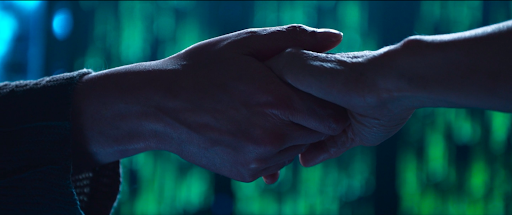
The magic power that gives them the ability to triumph over evil, to become their true selves again, to fly free and “paint the sky with rainbows” is their love; the everlasting love that brings them, and all mankind, together, symbolized by their hands interlocking. Never letting go. Across space and time and anything The Matrix tries to put between them, their love will always bring them together again.

It first might not seem possible that a film this self-reflexive and doom-pilled about the systems of power, and the control that birthed them, could also be so achingly sincere and relentlessly kind to the human beings trapped inside of those systems. But the true meaning of wisdom is holding two seemingly contradictory truths in our mind simultaneously: hope and despair, and knowing that they are both true.
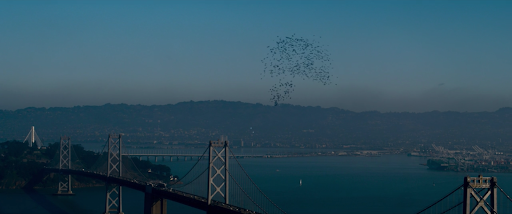
This is what the Wachowskis have always been trying to tell us, what they have been trying to teach us with their stories. That the meaning of life can only be found in the interlocking bonds of love and understanding that we share with others. The only choice we have in how we venture out into the increasingly scary and uncertain future is to choose love over hate, hope over despair. Even when despair and hate feel like the easier choice to make. The Wachowskis have been trying to tell us that the choice isn’t really a choice at all. You already know what you have to do.
“We can’t go back”
“We won’t”















Comments